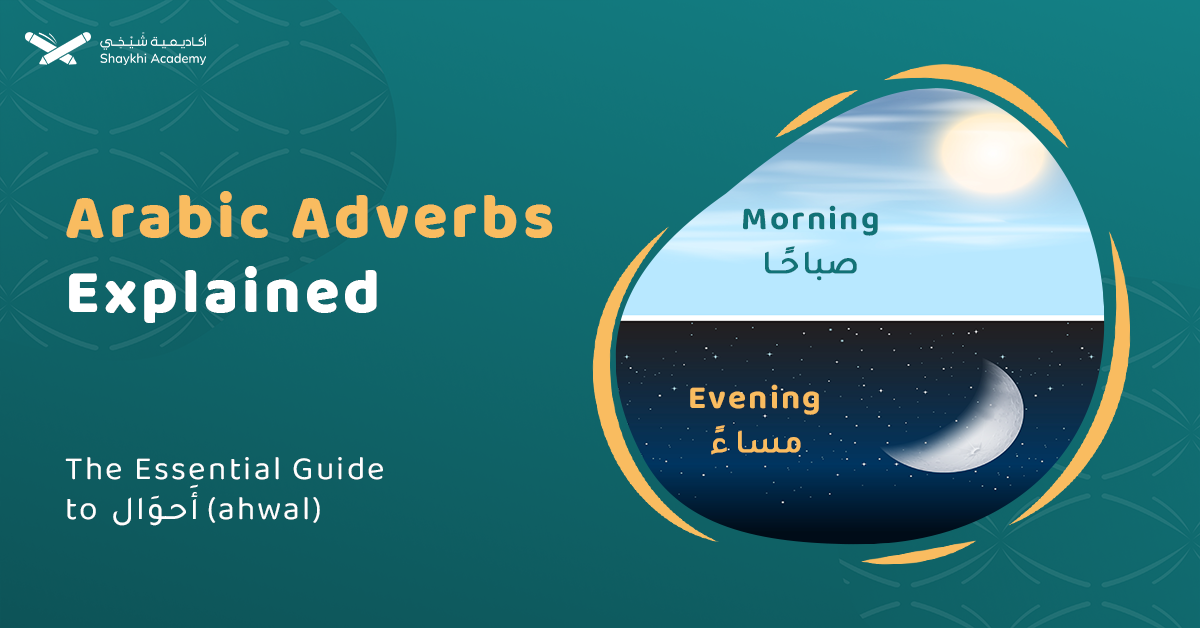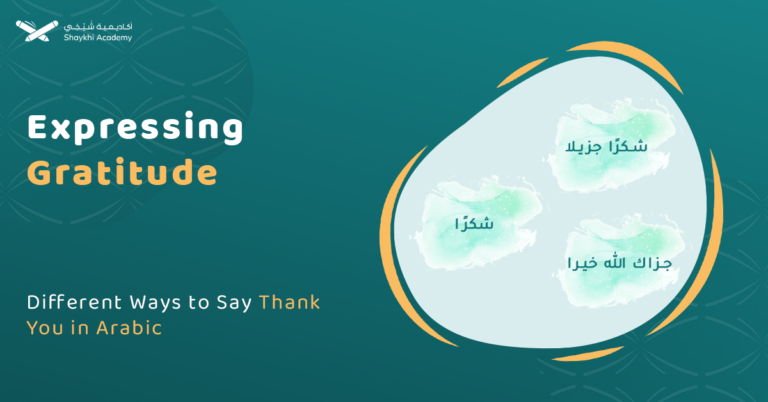The Arabic Adverbs are considered an essential component of the Arabic sentences. Comprehending the meaning and the correct usage of Arabic adverbs will enable you to express different types of information. Ultimately, you can say anything in Arabic as you hope.
This topic will detail Arabic adverbs, Zarfs, their types, their place inside the sentences, and the most common examples. This will lead us to the objectives and their types.
Definition of Arabic Adverbs أَحوَال (ʾaḥwal)
Arabic adverbs are words in verbal sentences. They modify the verb to provide additional details about the verb’s time, place, manner, and frequency.
Arabic adverbs primarily fall under the accusative case “nasb”. They usually have a فتحة (fatḥa) ending. Some Arabic adverbs have fixed forms (مبنية) without specific case markings, other adverbs are inflected words (معرب)
The following table shows the difference between fixed-form adverbs and inflected adverbs.
| fixed forms adverbs | Inflected adverbs | |||
| Definition | When the grammatical case of the adverb does not change whenever it is used. | It usually takes a tanween fatha “ ًا” in their ending | ||
| examples | حيثُ | haythu | where | مسرعًأ quickly |
| هنا | hunā | Here | ||
Most Arabic adverbs are أَحوَال (ʾaḥwal) that
أَحوَال (ʾaḥwal)
أَحوَال (ʾaḥwal) is a plural word, the one called ḥāl and it means an indefinite noun in the accusative case that explains the state of the subject, the object, or both together when the action occurs. The (ʾaḥwal) comes in the sentence in three phases as the following table.
| Sentence | Translation | Transliteration | The Type Of The Ḥāl |
| جاء رجل مبتسمًا | “A man came, smiling.” | Jāʾa al-rajulu mubtasiman | مبتسمًاsingle word adverb |
| جاء الرجل يبتسم | “A man came, smiling.” | Jāʾa al-rajulu yabtasim | يبتسم sentence as an adverb |
| دخل الطالب بسرور | “The student entered happily | Dakhala al-ṭālibu bi-surūr | بسرورphrase of a preposition as an adverb |
What Are the Types of Adverbs in Arabic Grammar?
According to the information they provide, Arabic adverbs can be categorized into four main categories.
1. Places Arabic Adverbs:
Place Arabic adverbs, such as “zarf makan,” can be defined as a word explaining the place where the verb was done. Simply, it is the answer to the question, “Where did this action happen?” The following table shows the most common place Arabic adverbs.
| Arabic | translation | transliteration |
| هُنَا | hunā | here |
| فَوْقَ | fawq | above |
| تَحْتَ | taḥt | under/ below |
| أَمامَ | Amam | In front of/ before |
| وَرَاءَ | warāʾ | behind |
| خَلْفَ | khalf | behind |
| إزاءَ | izāʾa | opposite/ facing |
| عِنْدَ | ʿinda | at |
| حِذَاءَ | ḥidhāʾa | Alongside/ next to |
| ثَمَّ | thamma | There “indicating a place” |
2. Time Arabic Adverbs :
Time Arabic adverb “zarf zaman” can be defined as a word that explains the time at which the verb was done. Simply, the answer to the question “When did this action happen?”.The following table shows the most common place Arabic adverbs.
| Arabic | translation | transliteration |
| مَسَاءً | masāʾan | in the evening |
| سَحَرًا | saḥaran | At dawn |
| صَبَاحًا | ṣabāḥan | In the morning |
| اليَوْمَ | al-yawma | today |
| أمسِ | ams | yesterday |
| غَـدًا | ghadan | Tomorrow |
| اللَيْلَةَ | Al laylaa | tonight |
| أَمَدًا | amadn | For a time |
| أَبَدًا | abadn | Forever |
| ظهرًا | zuhraan | In the afternoon |
3. Manner Arabic Adverbs:
They are adverbs that tell us about how the verb was done, they are usuallyʾaḥwalأحوال.
| sentence | Translation | transliteration | The Adverb |
| جاء الرجل سعيدًا | The man came happily | Jā’a ar-rajulu saʿīdan | سعيدًا |
| ذهبت للطبيب مسرعًأ | I went to the doctor quickly | Dhahabtu liṭ-ṭabībi musriʿan | مسرعًأ |
| شكوت لأخي باكيًا | I complained to my brother crying | Shakawtu li’akhī bākiyan | باكيًا |
| دعوت الله خاشعًأ | I prayed to Allah humbly | Daʿawtu Allāha khāshiʿan | خاشعًأ |
4. Frequency In Arabic Adverbs:
Frequency Arabic adverbs explain the frequency of the verb. They answer the question “How often does this action happen?”.The following table shows the most common frequency Arabic adverbs.
| Arabic | translation | transliteration |
| دائمًا | always | dāʾiman |
| عادةً | usually | ʿādatan |
| نادرًا | rarely | nādiran |
| أبدًا | Never | abadan |
| أحيانًأ | sometimes | ʾaḥyānan |
| مَرَّةً | once | marratan |
| مرتين | twice | marratayn |
| مِرَارًا-تكرارا | Repeatedly | mirāran-takraran |
| غَالِبًا | often | ghāliban |
If you want to know how to explain information, you can improve your conversational skills with our online Arabic speaking course.
Zarf in Arabic Grammar
The Zarf in Arabic grammar is a part of the Arabic adverb that is especially related to the time or the place. They are different from time and place names or in Arabic, Asma’ al-Zaman wa al-Makan “اسما الزمان والمكان”. These are nouns derived from verbs and come in special patterns such as “مَفعَل” (mafʿal) and “مَفعِل” (mafʿil). Here are 2 examples to make this clearer.
| pattern | verb | Asma’ al-Zaman wa al-Makan | translation | sentence |
| مَفعِل” (mafʿil | وعد | موعد | Today is the time for going out. | اليوم موعد الخروج |
| “مَفعَل(mafʿal | كتب | المكتب | The office is on the first floor. | المكتب في الطابق الأول |
Unlike the Zarf which comes in the accusative case, the grammatical case for Asma’ al-Zaman wa al-Makan depends on their position inside the sentence. You practice more examples with our Arabic course for adults. We can focus together on these grammatical aspects.
Read more about Arabic Negation And Its Types, Structures, and Examples of Negating Verbs and Sentences
What are almaf’ulat al-Khamsah المفعولات الخمسة?
The almaf’ulat al-Khamsah المفعولات الخمسة are five types of objects in the Arabic grammar. Their grammatical rule is the accusative case. They all explain some aspects of the verb. Below is a breakdown for each type:
1. Direct Object: المفعول به
The direct object (in Arabic maf’ūl bih) is the thing upon which the verb is done. For example when we say that Ahmed drinks milk. Milk is the thing that he drinks. So, to find it easily ask yourself using the following formula: What + the subject + the verb in the sentence?
Try doing this in the following sentences:
| sentence | translation | Transliteration | The direct object |
| شاهدتُ المسرحية. | I watched the play. | Shāhidtu al-masraḥiyyah. | المسرحية |
| قرأت الكتب | I read the books. | Qara’tu al-kutub. | الكتب |
| الطالب يرسم شجرة | The student is drawing a tree. | The student is drawing a tree. | شجرة |
There are 2 types of verbs in the Arabic language “لازم” Lazim which do not need an object such as the verb نام which means sleep. The other type is called Mota’adi (متعدي) which can have one object or two. This means that according to the verb, the sentence can contain one or more objects. Such as the following example:
| sentence | translation | transliteration | The 2 objects |
| ظننتك ذاهبًا إلى المنزل | I expected that you were going home | Ẓanantuka dhāhiban ilā al-manzil | The pronoun ك” (ka)and ذاهبًا |
2. Cognate Adverb: المفعول المطلق
The cognitive adverb (in Arabic maf’ūl muṭlaq) is the infinitive form of the verb. When the infinitive form of the verb comes with it in the same sentence. Cognate adverbs are used either to affirm the verb or to explain its number or its type by using an adjective. The following table explains this in detail.
| sentence | translation | transliteration | Cognate Adverb | The Role of the Cognate Adverb |
| ظهر القمر ظهورًا | The moon appeared. | Ẓahara al-qamar ẓuhūran. | ظهورًا | Affirming the verb |
| قرأت الدرس قراءة متأنية | I read the lesson carefully. | Qara’tu al-dars qirā’ah muta’aniyyah. | قراءة متأنية | Showing the manner of reading. |
| ضربه ضربتين | He hit it twice | Ḍarabahu ḍarbatayn. | ضربتين | Indicate the number of hits. |
3. Locative Adverb: المفعول فيه
The locative Adverb (in Arabic maf’ūl fīh) refers to the word that indicates the place or the time in which the verb was done. It bears inside it the meaning of “ في” or in. The locative adverbs are usually Zarf Zamman or Makan. You can practice many Arabic sentences in our Arabic reading course to recognize the adverb types.
4. Causative Adverb: المفعول لأجله
The causative adverb (in Arabic maf’ūl li-ajlih) comes as an indefinite word that answers the Question “Why was the verb done?” For example, try to find the causative adverb in the following sentences.
| sentence | translation | transliteration | The causative adverb |
| صليت راجيًا ثواب الله | I prayed hoping for a reward from Allah | Ṣallaytu rājian thawāb Allāh | راجيًا |
| اجتهدت رغبةً في النجاح | I worked hard desiring to succeed. | Ijtahadtu raghbatan fi an-najaaḥ | رغبةً |
5. The Adverb of Accompaniment: المفعول معه
The adverb of accompaniment (in Arabicmaf’ūl ma‘ah) is a noun that expresses happening alongside or accompanying another action without using the proposition “مع”. It is usually preceded by “و”.
See the following examples:
| sentence | translation | transliteration | The adverb of accompaniment |
| خرجت وشروق الشمس | I went out with the sunrise.” | Kharajtu wa shurūqa ash-shams | وشروق |
| سرت والجبل | I walked along with the mountain.” | Sirtu wal-jabala | والجبل |
Read more about Arabic Adjectives: A Comprehensive Guide to Usage, Agreement, And Types
Master all Arabic grammar with Arabic online Shaykhi Academy:
Learn all the Arabic language skills with our comprehensive Arabic online course. Whether you need to strengthen your reading or speaking skills our native Arabic instructors can help you build or improve your skills.
Do not miss the opportunity to learn Arabic can help you understand more than 25 countries in the Arabic world. This opens the door for you to much cultural and religious information. You have the flexibility to learn wherever and whenever you like.
Why Shaykhi Academy?
- Expert Native Tutors: Learn from highly qualified native Arabic speakers.
- Flexible Scheduling: Tailor your classes to fit your busy life.
- Affordable Learning: Access top-quality education at a price that suits you.
- Global Access: Study from anywhere in the world.
Explore Our Arabic Courses:
- Noorani Qaida: Build a strong foundation in Quranic Arabic.
- Comprehensive Arabic Courses: Master the Arabic language, from beginner to advanced levels.
- Fusha Arabic Classes: Delve into Modern Standard Arabic, the key to understanding literature, media, and formal communication across the Arab world.
- Quranic Arabic Course: Enhance your connection with the Quran by learning the language in which it was revealed.
Start Your Arabic Journey Today! Whether you’re just starting or looking to deepen your knowledge, Shaykhi Academy is here to support your journey. Book your free trial now and begin your path to Arabic mastery!

Conclusion
The Arabic adverbs explain many aspects that you may need to tell while you practice the Arabic language such as the manner, the quality, the time, and the place of the verb. Their grammatical case is accusative similar to The five objects (almaf’ulat al-Khamsah). They provide essential specifications for the verb. You can find the five types in the following poetic line.
“ضربت ضربا أبا عمرو غداة أتى و سرت والنيل خوفا من عتابك لي”
Translation:
I struck Abu Amr in the morning when he arrived, and I walked by the Nile, fearful of your reproach towards me.”
Can you now identify each type?
ضربًأ: it is derived from the verb so it is a cognate adverb
أبا عمرو:the verb occurs upon it, so it is a direct object
غداة: this word indicates the time of the verb, so it is a locative adverb
والنيل:this word means he walked alongside with Nile, so it is an adverb of accompaniment
خوفًا: this word shows the cause of the verb so it is a causative adverb


















































